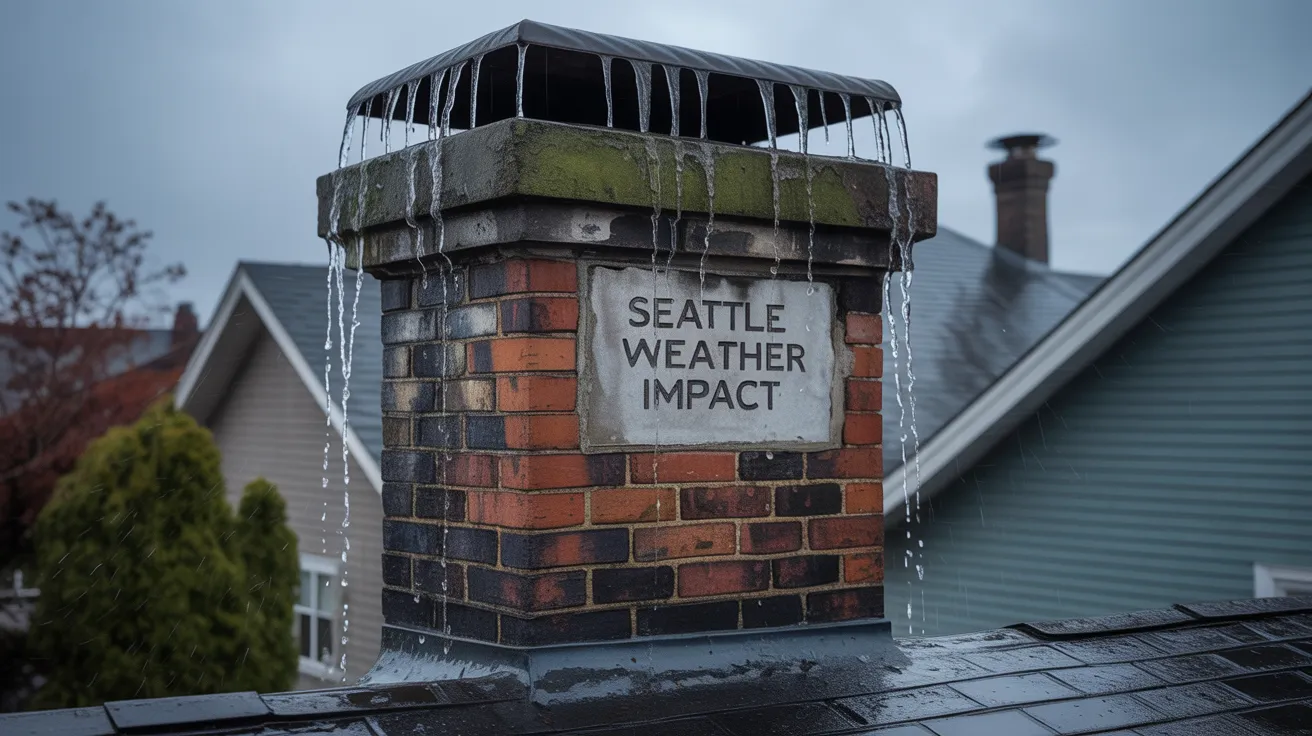If you require quick and dependable chimney repair in Seattle, don't overlook indicators such as damaged brickwork, dampness issues, or smoke backing into your home. Prompt response helps avoid safety risks and expensive structural issues typical of Seattle's damp weather. Depend on licensed experts for detailed evaluation, moisture testing, stonework restoration, and waterproofing—all following code-compliant methods and safety guidelines. Be preventive; periodic assessments and timely maintenance safeguard your home's efficiency and construction. Find out important guidelines and expert guidance to safeguard your chimney today.

Key Takeaways
Key Indicators Your Chimney Needs Repairs
Although your chimney appears intact from the outside, there may be warning signs revealing internal problems impacting safety and function. Be alert for smoke backing up into your living space, as this typically indicates chimney flue obstruction or deterioration. Significant soot deposits on interior surfaces or at the fireplace opening also signals poor airflow and increased fire risk. You could observe a noticeable, consistent smell—this usually suggests creosote or soot is building up, hampering proper airflow. Damaged mortar joints, shifting bricks, or apparent cracks suggest structural deterioration that can worsen quickly if ignored. By monitoring these indicators, you'll preserve your chimney's safety and reduce the risk of hazardous conditions. Arrange for a professional assessment when you notice any issues.
Seattle Home Chimney Problems: What to Know
In Seattle's humid climate, chimney deterioration often accelerates and creates unique maintenance issues for homeowners. Moisture infiltration leads to brick spalling, mortar deterioration, and oxidation of metal components. Without consistent chimney maintenance, harmful deposits gather swiftly due to the area's persistent precipitation and cool temperatures, elevating the danger of clogs and fire risks. You might also spot efflorescence—white staining—on your chimney, revealing water infiltration. Damaged or missing chimney caps let in precipitation and debris, further damaging structural integrity.
A comprehensive flue inspection is vital because continuous moisture promotes mold and deteriorates the flue liner, making it unsafe for venting exhaust and gases. Addressing these common issues with regular chimney cleaning and detailed flue inspection maintains your Seattle home's chimney safe and efficient.
The Importance of Timely Chimney Repairs
Fixing chimney issues quickly enables you to prevent costly structural damage that could impact your home's integrity. You'll also minimize fire risk by clearing hazards including creosote buildup along with masonry cracks. Prompt repairs guarantee your chimney operates efficiently, boosting both indoor comfort and energy use.
Preventing Structural Damage
As water seeps into your chimney structure, it accelerates brick deterioration, deteriorates the mortar, and compromises overall stability. When neglected, minor fissures grow, enabling increased moisture infiltration and causing major repair expenses or even structural failure. Routine maintenance enables early detection of these issues before they worsen, removing debris that can hold water near internal surfaces. Checking and upkeeping your flue lining is essential, as damaged linings expose masonry to damaging compounds and further water infiltration. By responding immediately, you prevent freeze-thaw cycles from creating brick damage and joint deterioration. Addressing minor damage now prevents extensive rebuilding later. Schedule professional assessments to guarantee your chimney's longevity, safety, and performance for years. Quick response preserves your home's structure and peace of mind.
Fire Risk Prevention
When your chimney shows cracks, loose bricks, or deteriorating mortar, it can quickly become a significant fire hazard. Structural defects and openings permit hot embers and dangerous heat to escape into adjacent combustible structures, raising the danger of a house fire. To ensure optimal chimney safety, you require quick repairs to address these problems and rebuild the chimney's integrity. Taking care of issues promptly makes certain that flammable creosote doesn't accumulate in unseen gaps, further reducing the possibility of combustion. In addition, deteriorated chimney liners can allow dangerous fumes to seep into your home, increasing safety concerns. Don't wait for small issues to worsen; immediate, professional service is essential for reliable fire protection and enduring safety in your Seattle home.
Improving Home Efficiency
While chimney issues typically seems minor at first, even tiny cracks or gaps can substantially impact your home's energy effectiveness. When your chimney develops problems, heated or cooled air leaks out, causing your climate control system to work harder. This not only elevates your monthly expenses but also puts unneeded strain on your heating and cooling equipment. Regular chimney fixes, along with routine chimney cleaning, guarantees your fireplace functions at peak performance and stops expensive energy leakage.
If you're thinking about installing a new fireplace, you need to tackle present chimney concerns. Damaged masonry or defective flue liners can significantly impact the effectiveness of modern fireplaces, decreasing their energy efficiency. When you repair your chimney in a timely manner, you'll ensure a pleasant indoor environment, realize lower energy costs, and guarantee your home's systems operate effectively and securely.
A Guide to Chimney Repair Procedures
We'll begin with a thorough inspection and damage assessment to identify potential safety or structural issues in your chimney. After identifying the problems, you can choose the most appropriate repair techniques, from masonry restoration to flue liner replacement. Every phase focuses on both the integrity and safety of your click here home.
Inspection and Damage Assessment
Before any repairs can begin, a thorough inspection and damage assessment is crucial for a safe and effective chimney repair process. You'll need a qualified professional to inspect your chimney thoroughly, identifying structural damage, cracks, and loose bricks. Close examination focuses on chimney soot buildup, which can conceal underlying damage and increase fire risks. The inspection includes investigating flue blockages, which could prevent proper ventilation of harmful gases and affect your home's air quality. Utilizing advanced technology and cameras, they'll investigate hard-to-reach spots, detecting signs of water damage, corrosion, or animal intrusions. With a comprehensive report of problem areas, you'll get detailed insight of necessary repairs, ensuring all repairs target root causes—not just surface symptoms.
Understanding Repair Techniques
Once the inspection reveals key concerns, the restoration work moves forward with targeted solutions aimed to bring back safety and performance. Technicians typically start with comprehensive soot clearance to remove dangerous deposits and enhance airflow. When the liner is compromised, they'll recommend liner repair or replacement to avoid harmful fumes from entering your home and to safeguard masonry from heat damage. Deteriorated masonry call for masonry repair or replacement to ensure the chimney's structural integrity. Moisture barriers may be applied to stop future moisture intrusion. For more severe damage, complete or partial reconstruction might be needed. Each restoration method strives to resolve the root causes, making certain your chimney continues to be secure, effective, and in line with Seattle's building codes.
Chimney Leak Assessment and Repair Options
Even though chimney leaks frequently go unnoticed until they create visible damage, prompt identification is crucial to preventing major structural issues and health risks. Look for warning signs such as water marks on ceilings or walls near your chimney, damp or musty odors, and oxidized firebox components. Professional chimney leak inspection involves a complete inspection of the crown, flashing, and cap to identify water infiltration areas. Technicians use dedicated tools to inspect unseen water damage and structural vulnerabilities. Once detected, established leak repair methods—including fixing flashing seals, installing new chimney caps, or adding waterproof coatings—can successfully fix the situation. By addressing leaks immediately, you'll protect your home from mold development, weakened masonry, and continued water issues, maintaining enduring chimney performance and safety.
Masonry Repair and Brick Replacement
If you notice brick damage or deterioration on your chimney, immediate repair work is crucial to maintain structural integrity and stop dangerous situations. Compromised masonry elements let water seep in, resulting in swift degradation and potential collapse. It's important to have a professional expert to evaluate the damage level, ensuring that the appropriate restoration procedures are used. During brick replacement, professionals methodically extract deteriorated units, find matching materials for your chimney, and utilize superior bonding materials for a flawless fix. This thorough procedure not only restores the chimney's appearance but also safeguards against further structural issues. Don't delay addressing these issues—addressing masonry problems early will prolong chimney durability and maintain household safety from potential dangers.
Professional Chimney Cap and Crown Services
Acting as your chimney's main protection against water infiltration and animal entry, their condition greatly influences your home's safety and the system's durability. Should your cap be compromised, missing, or deteriorated, water can seep down the flue, leading to interior deterioration and likely mold issues. A secure, securely mounted chimney cap also blocks wildlife, refuse, and rodents from obstructing your venting system. The chimney crown seals the top of your masonry, defending bricks and mortar from weather damage and erosion. Breaks or crumbling in the crown permit moisture to penetrate, weakening structural integrity. Periodic examinations and swift fixes of both the chimney cap and chimney crown help maintain you keep a safe, efficient, and enduring chimney system.
Finding the Best Chimney Maintenance Professional
Choosing a reputable chimney repair service provider demands careful review of qualifications, safety practices, and technical expertise. You need to confirm that the business possesses proper credentials, coverage, and certifications from established industry organizations. Question them regarding their experience with both chimney servicing and complex venting solutions to ensure they can address your system's unique needs. Professionals must adhere to current safety standards, utilize protective apparatus, and implement strict protocols to avoid mishaps or fire risks. Review their track record by investigating recommendations and reviewing customer reviews emphasizing dependability and professionalism. It's also crucial to confirm that they use industry-approved products and techniques for all work. By focusing on these elements, you'll guarantee your chimney repair work is completed securely, effectively, and to the premium technical standards.
Key Maintenance Guidelines for Your Chimney
Arrange periodic chimney inspections to discover safety hazards and structural problems before they worsen. Avoid creosote accumulation by following recommended cleaning timeframes and solely using properly seasoned firewood. It's also essential to implement appropriate waterproofing and sealing to protect your chimney from Seattle's regular precipitation.
Regular Chimney Inspections
Despite being frequently overlooked by homeowners, arranging routine chimney inspections is essential for keeping a reliable and properly functioning fireplace system. You should have your chimney inspected once every year by a licensed specialist who can spot structural issues, blockages, or signs of wear. Inspections play a critical role in maintaining chimney safety by detecting potential issues before they worsen. A complete inspection will also determine if a cleaning service is required to eliminate debris or obstructions that could impede proper ventilation. Professional inspectors use specialized tools and cameras to assess the entire chimney system, offering a thorough analysis. By prioritizing regular inspections, you'll safeguard your property against risks, increase your chimney's longevity, and maintain optimal fireplace performance.
How to Prevent Creosote Buildup
A few essential preventative maintenance procedures can considerably reduce the risk of creosote buildup inside your chimney. Make sure to burn well-dried hardwood, as it produces less smoke and minimizes residue. Confirm that your fireplace damper is opened entirely during operation to enhance airflow, which supports efficient combustion and reduces creosote formation. Schedule professional chimney maintenance at least once a year—creosote removal by a certified technician is vital to prevent dangerous accumulations. Monitor your firebox and flue periodically for early signs of buildup, such as dark, tar-like deposits. Resolve these swiftly to avoid a serious fire hazard. Don't overload the firebox or burn unapproved materials, as both can speed up creosote buildup. Maintaining these procedures will help keep your chimney more effective and secure.
Waterproofing & Sealing Solutions
Why does water infiltration pose such a significant threat to your chimney's integrity? When rain infiltration seeps into your masonry, it may lead to structural decay, brick damage, and metal corrosion. Moisture erodes mortar joints and provides perfect conditions for destructive freeze-thaw cycles, threatening the whole structure. To avoid these expensive problems, focus on effective waterproofing and sealing solutions.
Begin with a thorough examination for gaps and cracks that might permit water penetration. Then, perform a premium sealant treatment specifically designed for chimneys—avoid using standard water repellents, as they could lock in moisture. Verify the sealant is vapor-permeable, allowing the chimney to "breathe" while preventing rain infiltration. Routinely apply sealant every few years to maintain maximum protection. This preventative step prolongs your chimney's life and preserves your home secure.
Scheduling Your Chimney Inspection and Repair
To prevent escalating damage and safety hazards, schedule your chimney inspection and repair with a certified professional. A professional technician will conduct a comprehensive assessment, detecting any safety issues such as venting problems or pressing maintenance needs. Never postpone these crucial services—residue deposits or blockages can quickly become fire hazards or lead to harmful carbon monoxide infiltration in your residence.
Book your annual chimney maintenance, or following severe weather events, to verify your chimney's durability and performance. During the assessment, technicians use specialized tools to assess all chimney components, offering detailed guidance for any required maintenance work. By taking preventive measures, you'll avoid costly damage, maintain optimal air quality, and keep your heating system functions properly throughout the season.
Frequently Asked Questions
What is the Typical Cost of Chimney Repair in Seattle?
As you consider chimney repair in Seattle, you should expect to pay ranging from $300 for basic maintenance to $3,000 or more for complete overhauls. You'll want to schedule a chimney inspection first—specialists can identify hidden issues and guarantee safety. Chimney cleaning usually ranges from $150–$350 and could uncover repair needs. Be sure to employ certified technicians; they'll use proper materials and methods to maintain home safety and your fireplace functioning efficiently.
Are Permits Required for Seattle Chimney Repairs?
Wondering if you need permits for smaller projects! In Seattle, you must obtain a permit for the majority of chimney repairs, specifically those requiring structural modifications or masonry work. Even routine chimney cleaning and safety checks may require compliance with local codes to maintain safety. Always check with Seattle's Department of Construction and Inspections, because avoiding proper documentation could lead to major issues, inspection failures, or dangerous situations for your home and family.
Can You Use Your Fireplace During Ongoing Repairs?
Avoid using your fireplace during ongoing repairs. For optimal fireplace safety, wait for all repair work is done and thoroughly checked. Using your fireplace during repair work can create risks of structural failures, toxic fumes, or fire risks. Stay in contact with your contractor on repair scheduling and ensure when it's safe to resume use. Putting safety first guarantees your fireplace to operate safely and efficiently and protects your family and property.
Is Chimney Repair Included in Homeowners Insurance Coverage?
Consider insurance coverage as being similar to a protective shield—it will protect you from unexpected events, but not everyday wear and tear. Your home insurance policy could cover chimney repair when damage is caused by a protected incident, including falling trees or fire damage. You won't be covered for issues from lack of maintenance or wear and tear. To begin the claim process, document the damage thoroughly and contact your insurer promptly. Keep safety first by getting a certified professional evaluate your chimney's condition.
What's the Expected Timeline for a Standard Chimney Repair?
A normal chimney repair typically requires 1-3 days, depending on the extent of damage discovered during your chimney inspection. If the masonry restoration needed is minimal, you'll have a quicker completion. Major restoration projects, like sectional rebuilding, could increase the duration. You should focus on safety by scheduling a professional inspection beforehand, as this ensures all structural and ventilation issues are completely assessed before any masonry restoration or other repairs begin.
Conclusion
Stop waiting until your living room looks like a scene from Seattle's own version of "Old Faithful"—with debris erupting from your overlooked chimney. The warning signs are there, the dangers are obvious, so reach for your phone instead of a mop. Focus on safety and efficiency by scheduling a professional inspection today. With professional care and thorough inspection, you'll keep your home dry, your air clean, and prevent your chimney from becoming a safety hazard.
 Taran Noah Smith Then & Now!
Taran Noah Smith Then & Now! Tony Danza Then & Now!
Tony Danza Then & Now! Val Kilmer Then & Now!
Val Kilmer Then & Now! Marcus Jordan Then & Now!
Marcus Jordan Then & Now! Meadow Walker Then & Now!
Meadow Walker Then & Now!